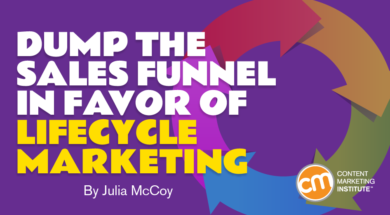 The sales funnel is obsolete.
The sales funnel is obsolete.
Bold statement? Yes, but when you look at the facts, it’s obvious.
The sales funnel doesn’t help predict anything about buyers: Not their mentality, not their movement through the buyer’s journey, and not when they might make a purchase.
In a recent Think with Google article, Lisa Gevelber, Google’s vice president of marketing for the Americas, discusses these new consumer behaviors and puts them in context:
People can’t remember what it was like to not be able to learn, do, or buy things when the need struck by reaching for the device in their pocket.
She goes on to name three new buyer behaviors/types:
- “Well-advised” consumer – Buyers want to make the right decisions, no matter how small, and they’re using their smartphones to get informed.
- “Right-here” consumer – Buyers expect mobile experiences, including shopping, to tailor to their physical location.
- “Right-now” consumer – Buyers want purchasing power no matter the time or place.
But how do they fit on the old marketing charts?
New buyer types: (1) well-advised; (2) right-here; (3) right-now consumers. @ThinkwithGoogle #Lisa Gevelber Click To TweetThe answer is no longer cut and dried. The sales funnel is too rigid to accommodate the modern buyer’s journey and too cold to represent the nurturing stance of content marketing. That’s why we need a more fluid, holistic model.
Enter lifecycle marketing.
From sales funnel to lifecycle marketing: a (brief) history
Before I get into the marketing lifecycle concept and why it works, let’s go back in history. The concept of marketing stages originated with the AIDA model – awareness, interest, desire, action – developed by E. St. Elmo Lewis in 1898.
As early as 1904, the model was illustrated as a chart, with each stage influencing and leading to the next stage. Here’s how it looked in the 1904 January-June issue of Salesmanship: A Magazine:
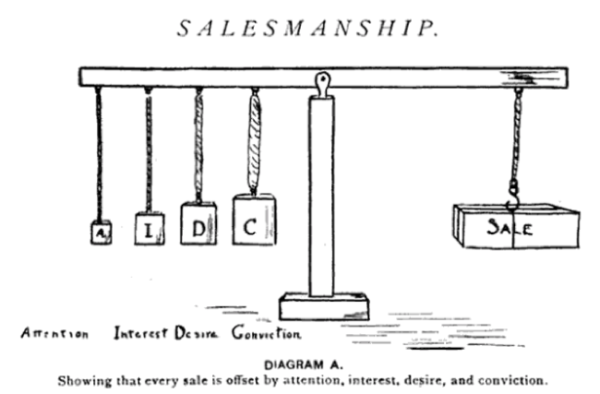
The idea of a “funnel” didn’t come into play until about 1924 when William Townsend wrote about it in his book, Bond Salesmanship:
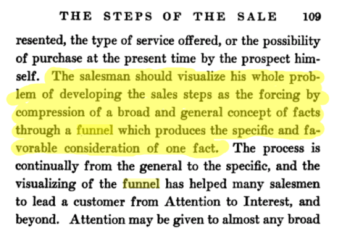
The salesman should visualize his whole problem of developing the sales steps as the forcing by compression of a broad and general concept of facts through a funnel which produces the specific and favorable consideration of one fact … The funnel has helped many salesmen to lead a customer from Attention to Interest, and beyond.
Unsurprisingly, this sounds nothing like what we need to do today to win a sale. This may have worked nearly 100 years ago, but the question remains:
Why are you relying on a century-old sales model in a post-internet world?
Why are you relying on a century-old sales model in a post-internet world? @JuliaEMcCoy Click To Tweet
The reliance on the sales funnel might have something to do with hard skills vs. soft skills.
What the heck am I talking about? Dale Carnegie’s updated book, How to Win Friends and Influence People in the Digital Age, delves into this. Here’s the gist:
Soft skills include ones that are harder to quantify, like empathy, kindness, etc. Meanwhile, hard skills like aggressiveness, pushiness, and assertiveness are quantifiable (you SEE the results from using those hard skills – maybe because they make you as intimidating as an angry gorilla) – and that’s why bosses love them still.
But, in the end, hard skills alone are bad for business. A study on failed CEOs revealed their businesses sank because they had only hard skills and no soft skills.
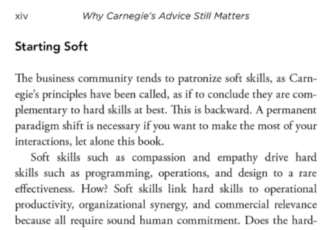
You can’t measure kindness for your customers, including the way you relate to them (listening, allowing them room to think, building a relationship – all soft skills). You can measure pushy tactics (the read rate on your overbearing emails, your close rate on rehearsed sales calls). The sales funnel aligns with that approach. After all, hard skills push your prospect through the funnel by force (or should I say, “by forcing of compression”?)
Soft skills don’t gel with the sales funnel. But they do gel with a marketing lifecycle.
A new model: lifecycle marketing
It’s time for a new sales model, one that aligns with content marketing, soft skills, and real buyer journeys in the internet age.
Marketing lifecycle aligns with #contentmarketing, soft skills, & real buyer journeys, says @JuliaEMcCoy. Click To TweetThis is the basic lifecycle chart I came up with after brainstorming, researching, and collaborating with my team.
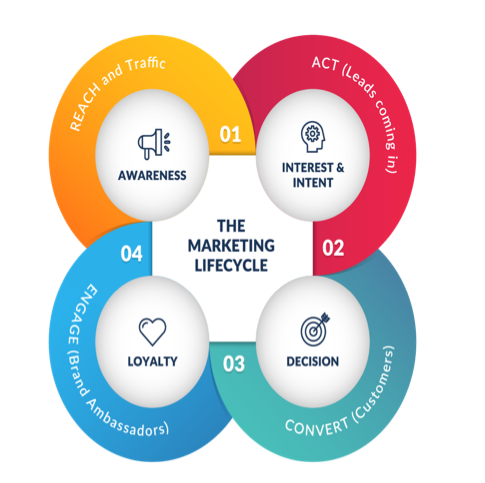
The idea of a marketing lifecycle is not new, but it’s newer than the sales funnel. Ardath Albee, who has been a longtime pioneer in our industry, spoke about “lifecycle marketing” on the Marketo blog.
She talks about shifting from “buying journey funnels” to “full-on customer lifecycle management.”
The difference is clear. A funnel focuses on squeezing your prospects into narrower and narrower stages, which ignores their freedom of choice and even their personal whims – both of which are influenced by the giant rabbit hole known as the internet, including:
- Online communities and forums
- Third-party reviews
- Social media
- Conversations online via email or chat (think peer referrals and recommendations)
- Search
- Content and resources
Imagine, for example, your buyer is in the interest-and-intent stage and finds competitor content that more thoroughly addresses their information needs. The buyer loses interest in you but is still aware of your brand. Whoops – the buyer just jumped backward a step in your marketing lifecycle chart.
Is that type of journey plottable on a sales funnel? No.
So, why a marketing lifecycle?
How lifecycle marketing works, and why it’s more relevant to today’s buyer
The talk in the marketing circles I’m in, from Mark Schaefer’s latest blogs about trust to LinkedIn conversations with executives and marketing teams, is about how slimy, cold sales tactics in marketing are falling by the wayside. That includes the overly aggressive sales funnel mentality. It runs directly opposite to the way buyers decide to buy online.
In contrast, if you think of our buyers in terms of where they land in the marketing lifecycle, you give them room to be human. Rather than a rigid chart, the marketing lifecycle is more of a series of open pathways. The buyers can move from one stage to another fluidly as they often do in real life – sometimes even backtracking or skipping a stage altogether.
Give your buyers room to be human – following the marketing lifecycle, says @JuliaEMcCoy. Click To TweetLuckily, each fluid stage is mapped to the type of content that will win them back. Targeted content marketing will continue to nurture your leads all the way to loyalty and through your marketing lifecycle on a continuous loop.
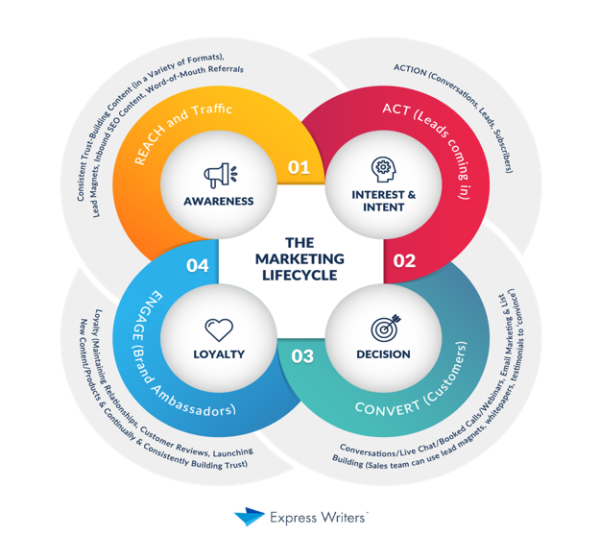
That’s hugely important, because, as Robert Rose writes, content marketing is the “heart” of any digital marketing strategy:
#Contentmarketing is the “heart” of any digital #marketing strategy, says @robert_rose. Click To TweetIn B2B, the entire lead generation strategy centers on customized content interactions that build trust over a long and complex buying journey … In B2C, today’s digital marketing is about the content-driven customer experience – and how to develop content that earns the ability to be organically shared.
How can you tie together content marketing with the marketing lifecycle and the buyer’s journey? I’ve outlined the four stages:
1. Awareness
A potential lead first hears about you. Your content here should be more value-focused, less promotional (leads are easily turned off by a sales pitch at this point).
Where is your lead in the cycle? Aware of your brand
What will appeal to leads at this stage? High-quality content that builds authority around your brand and domain, and establishes a base level of trust
What type of content/activity will encourage customer action?
- High-quality SEO blogs
- Original research studies, case studies, or round-ups
- Blogs that build brand awareness (creative stories, real-life experiences, pieces with entertainment value)
- Web pages and site guides
- Books published by a brand leader
- Lead magnets and e-books
- Social media content, videos, and copy
- Community around your brand and creation of intimacy with content
2. Interest and intent
Interest and intent stand for two, usually separate, stages of the sales funnel (interest and desire). The problem with that: Smart online buyers can move from interest to desire in a heartbeat.
Too many brands say goodbye to leads when all it takes is one moment for them to flip to wanting to purchase (or one well-timed coupon sent in an email). What propels this flip most often? Real-time human conversations, whether via live chat, a Skype call, or over the good ol’ phone.
Once your leads are warm (thanks to your awareness-targeted content), getting them to have a conversation with your best salespeople is easier. And, those conversations have a ton of pull, especially if you sweeten things with a discount (with an expiration date attached).
According to GeoMarketing, customers exchange more than 2 billion messages with businesses on Facebook every single month. Whatever platform you use, if you can engage with prospects one to one, you’ll have a better chance of moving them to want to purchase.
Where is your lead in the cycle? Interested in your brand with potential intent to buy
What will appeal to leads at this stage? Conversational marketing, including live calls and chats, and offers (seasonal or client-specific offers work well)
What type of content/activity will encourage customer action?
- Conversational marketing (e.g., live chat, messenger bots, and booked calls with your best team members)
- Clear website navigation, strong CTAs, and contact forms (I.e., make it easy to contact your team from your website)
- Lead magnets and e-books
- Digestible client success stories (white papers and case studies)
- List-building (including exceptional email marketing)
- Webinars
- Retargeting campaigns
3. Decision
The decision stage is the action stage. The desired action is, of course, the sale. If your targeted content has worked well at the other stages (filling information needs, answering questions, building authority, building trust), and your product/service is strong, this stage is where it all pays off.
Where is your lead in the cycle? Primed and ready to purchase
What will appeal to leads at this stage? Work/product samples and price quotes, good reviews from happy customers, and booking sales calls
What type of content/activity will encourage customer action?
- Conversational marketing (following up and answering customer questions)
- A team quick on its feet to get back to customer inquiries (According to a study by Lead Connect, 78% of customers buy from the first brand to respond to their questions.)
- Positive reviews on major third-party sites
- Product demos if they make sense for your brand
4. Loyalty
The loyalty stage doesn’t exist in the traditional sales funnel, but it’s incredibly important for longevity and profitability online. Instead of spitting out your customers after they purchase, lifecycle marketing keeps them in the loop. It’s about providing consistent value through content, touching base with them with conversational marketing, and maintaining that relationship you already built. This is how you earn loyal brand advocates.
Earn loyal brand advocates by providing consistent value through #content, says @JuliaEMcCoy. Click To TweetWhere is your lead in the cycle? Delighted, satisfied, and ready to refer/recommend you
What will appeal to leads at this stage? Fantastic service and great products, friendly follow-ups, addressing any possible dissatisfaction
What type of content/activity will encourage customer action?
- Regular follow-ups
- Thank-you gifts
- Email marketing with content updates
- Releases of new products or offerings
- Combination of great service and great products
Marketing lifecycle is a better framework for online buyer’s journey
Which model would you rather have as part of your marketing strategy: (1) One that’s 120 years old and speaks to buyers making purchase decisions in person or (2) One that directly correlates to the online buyer’s journey, that aligns with the warmth of content marketing, and guides you on what to create to keep prospects in your circle?
Lifecycle marketing is not easy, but it’s a better way to serve your customers who are looking for value and brands they can trust. Companies that provide quality content and service at each stage will ignite loyalty in their customers, creating devoted fans and advocates.
And that’s better for everyone.
Content Marketing World offers a great opportunity to learn about finding a better way to deliver what your audience needs. Register today for the best available rates. Use code BLOG100 to save an additional $100.
Cover image by Joseph Kalinowski/Content Marketing Institute

